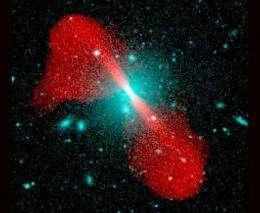Cosmic radio beacons

(PhysOrg.com) -- Because all cosmic objects evolve with time, astronomers sometimes have a difficult time deciding if two sources that seem different are actually related but just in different stages of life.
A case in point: galaxies that emit strong radio emission. Since they were first studied over fifty years ago, it has been known that, broadly speaking, they tend to fall into two groups distinguished by their radio luminosities, either modest or very bright. The problems are in deciding whether they are intrinsically similar, but observed with differences due to their ages or perhaps to our viewing angle (since they are disk-shaped, obscuring material in the plane can block emission), and how they might be related to other, more famous, optically luminous galaxies like quasars.
CfA astronomer Aneta Siemiginowska teamed with three colleagues to analyze a new sample of forty-four radio galaxies, selected from recent radio surveys, whose luminosity and other characteristics make them appear part of a uniform class of low luminosity radio sources. The sizes of the radio sources are all smaller than that of the host galaxy. By correlating the physical sizes with their luminosities, and by building on previous studies of classical radio galaxies, the astronomers find that as a group the new sources are faint for their sizes, and they argue this indicate that the emission is short-lived, and is the result of a interim period of activity.
The scientists argue that active events like these are characteristic of an early stage in the evolution of radio galaxies as they fragment -- but the reasons for fragmentation are still not clear. The fragments in turn, they suggest, evolve into the classical bright group of radio sources. The reasons this happens is still unclear, but the new work provides a large, homogeneous new sample of objects to probe the early stages in the development of these cosmic radio beacons. The relatively large sample size makes it possible to reach credible general conclusions even though the character of any one of the new radio sources might be ambiguous.
Provided by Harvard-Smithsonian Center for Astrophysics




















